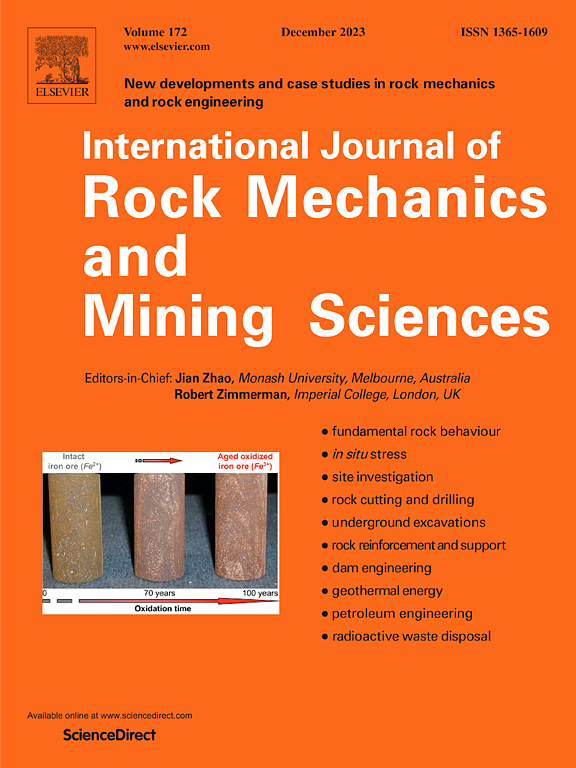Enhancing fracture conductivity in carbonate formations through mineral alteration
IF 7
1区 工程技术
Q1 ENGINEERING, GEOLOGICAL
International Journal of Rock Mechanics and Mining Sciences
Pub Date : 2025-02-01
DOI:10.1016/j.ijrmms.2025.106027
引用次数: 0
Abstract
In geothermal, oil, and gas reservoirs, the conductivity of hydraulic or acid-etched fracture determines efficient and economical resource exploitation. Proppant embedding or acid-rock reaction weakening rock leads to a sharp decline in fracture conductivity. Mineral alteration is a technique of in-situ transformation of existing minerals into harder minerals to improve rock strength, and diammonium hydrogen phosphate (DAP) has been shown to be an effective mineral alteration agent for high-porosity and high-permeability carbonate rocks at low temperatures. This work studied the effect of 10 wt% HCl and 0.8 M DAP solution on the hardness of rock samples (0.36%–1.31 % porosity and 2.72–17 × 10−6 μm2 permeability) at 25, 80, 140 and 200 °C. The experimental results proved the weakening effect of acid and the strengthening effect of DAP on rock. The mechanism of hardening caused by DAP treatment and the positive effects of high temperature were revealed. As the temperature increased, the chemical reaction between DAP and rock accelerated, resulting in an increase in the amount of reaction products (calcium phosphate) and higher crystallinity, which made the rock harder. Even at ultra-high temperatures (200 °C), DAP treatment remained remarkably effective for very dense rock samples. In addition, the relationship between rock hardness and rock embedding strength was established. The fracture conductivities under different rock hardness were calculated by Nierode-Kruk correlation and numerical method. The results indicated that it was feasible to improve the fracture conductivity through DAP treatment at high temperatures. This study provides a theoretical basis for creating high-conductivity fractures through mineral alteration in deep carbonate reservoirs.
通过矿物蚀变提高碳酸盐岩地层裂缝导流能力
在地热、油气储层中,水力裂缝或酸蚀裂缝的导流能力决定着资源的高效经济开采。支撑剂嵌入或酸-岩反应削弱岩石,导致裂缝导流能力急剧下降。矿物蚀变是将现有矿物就地转化为较硬矿物以提高岩石强度的一种技术,磷酸氢二铵(DAP)已被证明是低温下高孔高渗碳酸盐岩的有效矿物蚀变剂。本文研究了10 wt% HCl和0.8 M DAP溶液在25、80、140和200℃下对岩石样品硬度(孔隙度0.36% ~ 1.31%,渗透率2.72 ~ 17 × 10−6 μm2)的影响。实验结果证明了酸对岩石的弱化作用和DAP对岩石的强化作用。揭示了DAP处理的硬化机理和高温的积极作用。随着温度的升高,DAP与岩石之间的化学反应加速,导致反应产物(磷酸钙)的数量增加,结晶度提高,使岩石变硬。即使在超高温(200°C)下,DAP处理对于非常致密的岩石样品仍然非常有效。此外,还建立了岩石硬度与岩石抗压强度之间的关系。采用Nierode-Kruk关联和数值方法计算了不同岩石硬度下的裂缝导流能力。结果表明,在高温下通过DAP处理提高断裂导电性是可行的。该研究为深部碳酸盐岩储层蚀变造高导流裂缝提供了理论依据。
本文章由计算机程序翻译,如有差异,请以英文原文为准。
求助全文
约1分钟内获得全文
求助全文
来源期刊
CiteScore
14.00
自引率
5.60%
发文量
196
审稿时长
18 weeks
期刊介绍:
The International Journal of Rock Mechanics and Mining Sciences focuses on original research, new developments, site measurements, and case studies within the fields of rock mechanics and rock engineering. Serving as an international platform, it showcases high-quality papers addressing rock mechanics and the application of its principles and techniques in mining and civil engineering projects situated on or within rock masses. These projects encompass a wide range, including slopes, open-pit mines, quarries, shafts, tunnels, caverns, underground mines, metro systems, dams, hydro-electric stations, geothermal energy, petroleum engineering, and radioactive waste disposal. The journal welcomes submissions on various topics, with particular interest in theoretical advancements, analytical and numerical methods, rock testing, site investigation, and case studies.

 求助内容:
求助内容: 应助结果提醒方式:
应助结果提醒方式:


